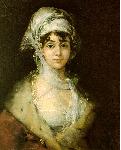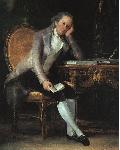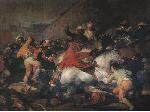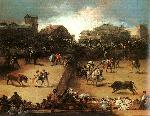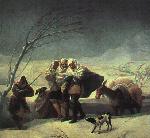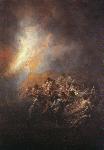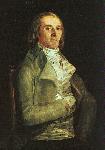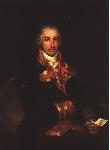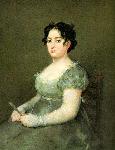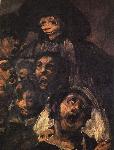Learn about Francisco Goya in Art History, View His Art and Famous Paintings
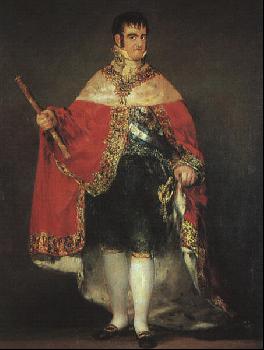
"Ferdinand VII in his Robes of State”,
Francisco Goya, 1814
Francisco Goya, 1746-1828, another of Spain’s famous artists in art history was a contemporary of Jacques Louis David. He was a technically a realist in his art because he painted the way things are. He was not an idealist.
In one of Goya’s most famous paintings (an etching)"The Sleep of Reason Produces Monsters", the artwork appears to be a fantasy, giving reason to call Goya a romanticist. Goya's perception of reality was that the philosopher's dream of reason had produced human monsters. The monsters were men with no integrity, they were liars, cheaters, distorters of the truth, all consumed with avarice and greed. This is Goya’s objectivity without illusion that classifies him a realist artist. Goya saw the world for what it was, mostly violent. He didn't agree with what he saw and he realized he couldn't change it. Realism is not a comment on the way Goya applies paint to canvas.

Many of Francisco Goya's art prints and paintings were political in nature. "Ridiculous Folly", 1813-1820, he depicts man's inability to come to a point of reason. A contemporary philosopher is out on the end of a rotten branch teaching a group of deaf, dumb and blind students about current wisdoms, totally unaware he will be soon falling into the abyss.
In 1800 Goya was working in the court of Spain, surrounded by men whom to his own thinking were human monsters. They were stupid, violent, corrupt, greedy men lacking in integrity. During this time he was commissioned to paint another of his famous paintings in art history, "The Family of Charles IV", a group of pompous arrogant people. Francisco Goya saw the family Royal Family as abnormal, and he painted them that way.

The King is loaded down with medals and ribbons sporting a vacuous look on his face. All are dressed in their finest ribbons and silks. The homely Queen stands center stage holding the hand of her son with an arm around her daughter. Both children are not direct lineage of the
King. They are children of the Queen through a relationship with Manual Godoy. The Queen looks a little stiff and standoffish in motherly contact with her children suggesting the familiar gestures were rare. The children do not have child-like faces, but a demeanor that looks rather hard more like their counterpart parents. Ferdinand, the heir to the throne, stands stupidly front stage left decked in his best, and behind him is the ugly witch-like face of the King's sister. Toward the deep background left is a shadowy portrait of Goya himself, painting the very picture we are looking at. Unbelievably the Royal Family accepted this picture apparently not seeing the underlying truth.
Francisco Goya witnessed the Napoleonic invasions of Spain between 1808 and 1814 the Inquisition return under Ferdinand VII. Goya’s art recorded the atrocities of war and mans inhumanity to man. His etching "And Nothing Can Be Done about It" 1810-20, is a man slumping at the stake, having been shot. Others having met the same fate are
lying dead on the ground. Goya’s art is about representing the evil atrocities of the day. He never attempts to suggest a solution.
Francisco Goya's art, the Caprichos prints, is a comment on the dark side of humanity, and in some cases the prints become representations of the damnation of humanity. This is expressed in "Saturn Devouring His Sons", an artful comment on the romantic dreams of men and their noble passions dominating the time in which he lived. Goya felt man totally misunderstood the reality of their passions and eventually would be destroyed by them.
In Goya's portrait Marquesa de La Solana", 1791-
95, he painted a simplified unidealized art portrait. He chose simplification over detail when he rendered the dress and shawl, thereby calling attention to character in the face. The contrast of the blacks and grays against the pink of the face and the ribbon on the head, bring a heightened life to the portrait.

Francisco Goya searched for a way to bring both immediacy and impact of an action directly to the viewer, as he himself saw it and confronted it. The human eye doesn't see all detail at once as a camera does. The human eye captures the essence of things in immediacy and is later examined for detail. In this vein Goya painted two more famous paintings "Nude Maja", and "Clothed Maja" in 1797-98, as experimentations rendering immediacy of the moment. His effort was bringing the image and his emotional response to the viewer.

"The Toreador Jose Romero", is a portrait of a bullfighter’s character. Where a lesser artist would have painted the bullfighter in a typical bullfighting stance, Francisco Goya attempted to bring out his personality with surface paint qualities. Goya did not by paint detail in his art, but painted what his eye saw in an instant of time.

One of Goya's most famous paintings in art history is "The Executions of May 3,1808", painted in 1814. The citizens of Madrid had rioted and were lined up the next day in front of a French firing squad. The "Executions" lives up to Francisco Goya's system for Immediacy. He states, "only forms, forms that are lighted and forms that are not, planes that are near and planes that are far, projections and hollows". Goya’s art is not interested in recording all detail, just the sum effect of all detail in an instant. This painting delivers the immediacy of the event and the defiance of those were being shot. Other famous artists of realism are Honore’ Daumier, Gustave Courbet, and Corot.
To view the entire gallery of Francisco Goya paintings, click here.
Click on the graphics below to increase graphic sizes. At the same you time can also view an opportunity to purchase a poster or painting reproduction.
